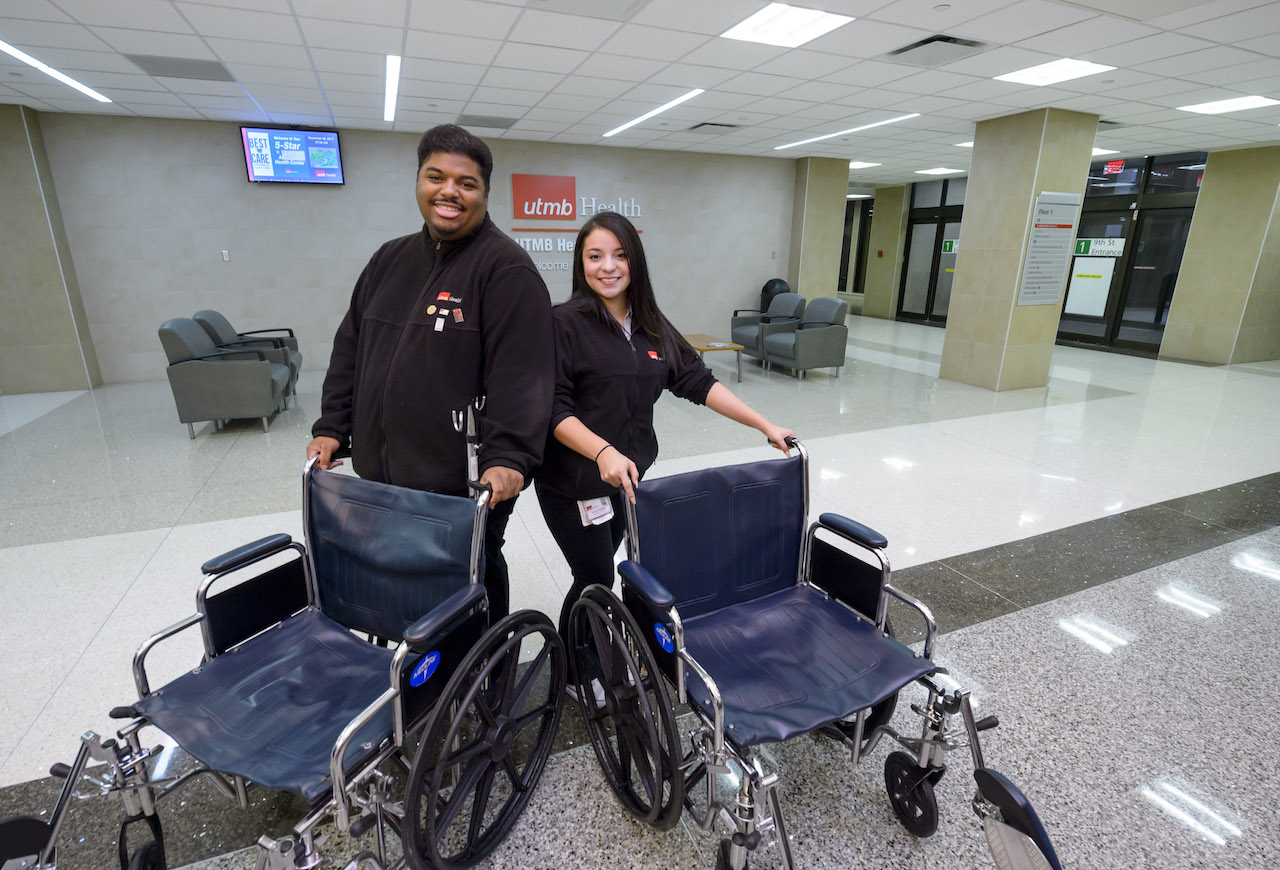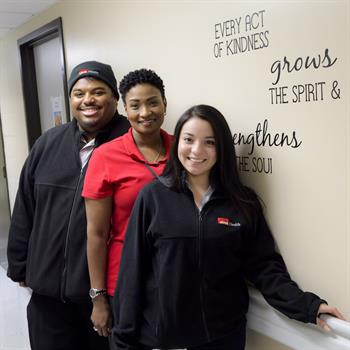
For Jeimmy Banegas and Darion Alexander, working as patient transporters means much more than just taking patients from point A to point B.
It’s about providing excellent customer service, supporting patients when they need it most—and always greeting everyone who comes through the door with a smile.
“I have a sunny disposition—that’s the way I prefer to be,” says Alexander as he arrives to UTMB’s Galveston Campus on a morning that is anything but sunny.
In fact, the December day I meet up with Banegas and Alexander is downright miserable, with freezing rain and high winds. Dressed in warm clothes and rain jackets, the pair doesn’t let the wintry conditions dampen their mood as they prepare for the day ahead.

For the past two years, they have have worked as a team for Hospital Transportation Services, stationed next to the parking garage behind UTMB Health Clinics, commonly referred to as “UHC.” From there, they stand ready to assist anyone who needs help getting to or from their outpatient clinic appointment. On average, the two help transport about 60 to 70 patients a day by wheelchair to the clinics—which cover a variety of specialties such as dermatology, cancer care and endoscopy.
Banegas and Alexander take turns saying “Good morning!” to UTMB employees who are making their way from the parking garage to the main building. Even serious-looking passersby can’t help but crack a smile when they see the duo intently wiping down wheelchairs and lining them up in preparation for patient arrivals.
“It can get really busy, so we try to have a dozen or so wheelchairs cleaned

and ready to go,” explains Banegas. “That way we don’t have to leave patients waiting while we go round the wheelchairs up later.”
Just before the outpatient clinics open at 8 a.m., vehicles dropping off patients begin arriving at the parking garage. Some patients are accompanied by family members, others come alone.
“Many times, people may be worried, confused or in pain— because either themselves or a family member are sick or hurt,” says Alexander. “So always expressing kindness and a simple smile can go a long way.”
Banegas approaches one woman who is on her own and is unable to walk very far without stopping to sit. She grabs a wheelchair and gently helps the woman into it—and the two immediately strike up a conversation in Spanish. She asks for the woman’s name and appointment info, which she writes down into a log book. Then they’re off—up a ramp and into the much warmer UHC building.

“Don’t forget your parking garage ticket if you have one,” Banegas says in Spanish after tucking a blanket around the patient’s legs.
Banegas doesn’t leave the patient once they get to the designated clinic—instead, she helps the woman check in for her appointment and asks if she would like any water while she waits. Once the patient is settled, Banegas reassures her that she will be back after the appointment to wheel her back to her car.
“We have a cell phone that the clinic will call when patients have finished up their office visits and are ready to be transported back to the parking garage or to another appointment,” she says.
In the meantime, Banegas heads back down to the patient drop-off area to see if there are any more people who need help. As we get off the elevator into the main lobby, Alexander waves as he approaches, pushing another patient. It’s impressive to watch the team of two in action—they treat each person with individualized care, interacting in a way they feel is most helpful and supportive.
“I like to meet new people all the time—it keeps things interesting, and you

never know who you may meet or what kind of difference you may make,” says Alexander. “A lot of times, we become attached to our ‘regulars’ who are here a lot. It’s fun because they look forward to seeing us.”
It’s obvious Alexander and Banegas are a favorite among patients and employees. They humbly admit to receiving positive comments and fan mail on a regular basis. Some patients make special requests to be transported by Alexander or Banegas to the clinics—or even all around John or Jennie Sealy hospitals. LaTayna Hill, a patient service specialist in the endoscopy clinic, now counts the two patient transporters among her close friends.
“I wouldn’t trade them for anyone,” says Hill. “It’s about putting patients first and that’s what they do—and patients love them. When I worked in radiation oncology, I had a patient who wouldn’t let anyone besides Jeimmy or Darion take her to and from appointments. I guess everyone has their favorites—and they are a lot of people’s favorites!”

Hill adds that Alexander and Banegas have a patient demeanor and are always willing to go the extra mile for anyone. The two have many patient stories—some heartwarming, some adrenaline-provoking. In addition to having the occasional stroke, heart attack or laboring patient who needs to be run to the Emergency Department, Alexander recalls one regular patient who is terribly afraid of elevators. Instead, he helps the patient walk up and down the five flights of stairs whenever they come to the UHC for an appointment.
“I definitely get my exercise doing this job,” he says smiling.
Another common dilemma is when patients forget where they parked.
“Sometimes you’ll see us going around and around with a wheelchair all over the parking garage to find someone’s car,” laughs Banegas.

By 1 p.m., I’ve lost count of the number of patients Banegas and Alexander have greeted or wheeled to an appointment. In addition to monitoring patients coming to and from the parking garage next to the UHC, the two take turns checking to see if any cars, taxis or shuttles pull up in an adjacent garage next to the ED. And if a patient is done with their appointment and is waiting to be picked up, Alexander and Banegas try to make them as comfortable as possible.
“Sometimes patients may wait several hours for their transportation to pick them up,” says Alexander. “We’ll call their shuttle or taxi service to get a guestimate of when they will get here to help relieve any stress or anxiety the patient is feeling. In the meantime, we try to provide them with good company, water and snacks.”

It’s not a glamorous job and it can be tough at times, but he and Banegas enjoy every day that they are able to help a patient and keep the Health System running efficiently.
Alexander takes one more person to an appointment before breaking for a quick lunch. The patient, who has seen either Alexander or Banegas every day for the last three weeks of his radiation therapy, lights up when he describes the impact they’ve had on him.
“They take great care of me,” he says. “They are just as good as gold.”